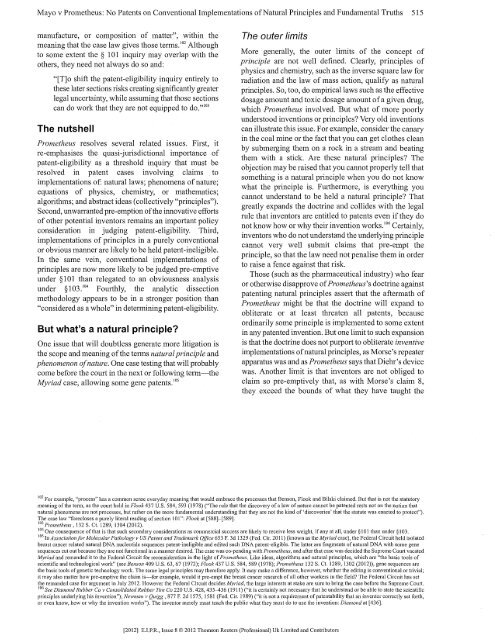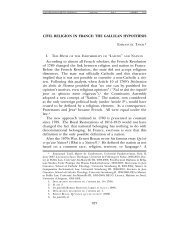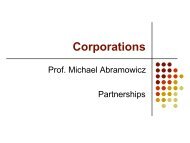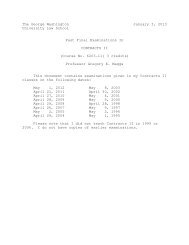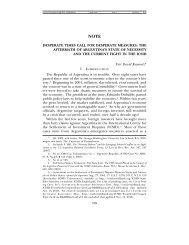Mayo v Prometheus - Gwu - George Washington University
Mayo v Prometheus - Gwu - George Washington University
Mayo v Prometheus - Gwu - George Washington University
You also want an ePaper? Increase the reach of your titles
YUMPU automatically turns print PDFs into web optimized ePapers that Google loves.
<strong>Mayo</strong> v <strong>Prometheus</strong>: No Patents on Conventional Implementations ofNatural Principles and Fundamental Truths 515<br />
manufacture, or compos1t10n of matter", within the<br />
meaning that the case law gives those terms. 102 Although<br />
to some extent the § 101 inquiry may overlap with the<br />
others, they need not always do so and:<br />
"[T]o shift the patent-eligibility inquiry entirely to<br />
these later sections risks creating significantly greater<br />
legal uncertainty, while assuming that those sections<br />
can do work that they are not equipped to do." 103<br />
The nutshell<br />
<strong>Prometheus</strong> resolves several related issues. First, it<br />
re-emphasises the quasi-jurisdictional impmtance of<br />
patent-eligibility as a threshold inqui1y that must be<br />
resolved in patent cases involving claims to<br />
implementations of: natural laws; phenomena of nature;<br />
equations of physics, chemistry, or mathematics;<br />
algorithms; and abstract ideas (collectively "principles").<br />
Second, unwarranted pre-emption of the innovative efforts<br />
of other potential inventors remains an important policy<br />
consideration in judging patent-eligibility. Third,<br />
implementations of principles in a purely conventional<br />
or obvious manner are likely to be held patent-ineligible.<br />
In the same vein, conventional implementations of<br />
principles are now more likely to be judged pre-emptive<br />
under § 101 than relegated to an obviousness analysis<br />
under § 103. 104 Fourthly, the analytic dissection<br />
methodology appears to be in a stronger position than<br />
"considered as a whole" in determining patent-eligibility.<br />
But what's a natural principle?<br />
One issue that will doubtless generate more litigation is<br />
the scope and meaning of the terms natural principle and<br />
phenomenon of nature. One case testing that will probably<br />
come before the court in the next or following term-the<br />
Myriad case, allowing some gene patents. 105<br />
The outer limits<br />
More generally, the outer limits of the concept of<br />
principle are not well defined. Clearly, principles of<br />
physics and chemistJy, such as the inverse square law for<br />
radiation and the law of mass action, qualify as natural<br />
principles. So, too, do empirical laws such as the effective<br />
dosage amount and toxic dosage amount of a given drug,<br />
which <strong>Prometheus</strong> involved. But what of more poorly<br />
understood inventions or principles? Very old inventions<br />
can illustrate this issue. For example, consider the canary<br />
in the coal mine or the fact that you can get clothes clean<br />
by submerging them on a rock in a stream and beating<br />
them with a stick. Are these natural principles? The<br />
objection may be raised that you cannot properly tell that<br />
something is a natural principle when you do not know<br />
what the principle is. Furthermore, is everything you<br />
cannot understand to be held a natural principle? That<br />
greatly expands the doctrine and collides with the legal<br />
rule that inventors are entitled to patents even if they do<br />
not know how or why their invention works. 106 Certainly,<br />
inventors who do not understand the underlying principle<br />
cannot very well submit claims that pre-empt the<br />
principle, so that the law need not penalise them in order<br />
to raise a fence against that risk.<br />
Those (such as the pharmaceutical industry) who fear<br />
or othe1wise disapprove of <strong>Prometheus</strong>'s doctrine against<br />
patenting natural principles asse1i that the aftermath of<br />
<strong>Prometheus</strong> might be that the doctrine will expand to<br />
obliterate or at least threaten all patents, because<br />
ordinarily some principle is implemented to some extent<br />
in any patented invention. But one limit to such expansion<br />
is that the doctrine does not purpmi to obliterate inventive<br />
implementations of natural principles, as Morse's repeater<br />
apparatus was and as <strong>Prometheus</strong> says that Diehr's device<br />
was. Another limit is that inventors are not obliged to<br />
claim so pre-emptively that, as with Morse's claim 8,<br />
they exceed the bounds of what they have taught the<br />
102 For example, "process" has a common sense everyday meaning that would embrace the processes that Benson, Flook and Bilski claimed. But that is not the statutmy<br />
meaning of the term, as the comi held in Flook 437 U.S. 584, 593 (1978) ("The rule that the discovery of a law of nature cannot be patented rests not on the notion that<br />
natnral phenomena are not processes, but rather on the more fundamental understanding that they are not the kind of 'discoveries' that the statnte was enacted to protect").<br />
The case law "forecloses a purely literal reading of section I 01 ":Flook at (588]-[589].<br />
103 <strong>Prometheus</strong>, 132 S. Ct. 1289, 1304 (2012).<br />
104 One consequence of that is that such secondary considerations as commercial success are likely to receive less weight, if any at all, under § 10 I than under§ 103.<br />
105 In Association/or Molecular Patlwlogy v US Patent and Trademark Office 653 F. 3d 1329 (Fed. Cir. 2011) (known as the M:vriad ease), the Federal Circuit held isolated<br />
breast cancer related natnral DNA nucleotide sequences patent-ineligible and edited such DNA patent-eligible. The latter are fragments ofnatnral DNA with some gene<br />
sequences cut out because they are not functional in a manner desired. The case was co-pending with <strong>Prometheus</strong>, and after that ease was decided the Supreme Court vacated<br />
Myriad and remanded it to the Federal Circuit for reconsideration in the light of <strong>Prometheus</strong>. Like ideas, algorithms and natural principles, which are "the basic tools of<br />
scientific and technological work" (see Benson 409 U.S. 63, 67 (1972); Flook 437 U.S. 584, 589 (1978); <strong>Prometheus</strong> 132 S. Ct. 1289, 1302 (2012)), gene sequences are<br />
the basic tools of genetic technology work. The same legal principles may therefore apply. It may make a difference, however, whether the editing is conventional or trivial;<br />
it may also matter how pre-emptive the claim is-for example, would it pre-empt the breast cancer research of all other workers in the field? The Federal Circuit has set<br />
the remanded case for argument in July 2012. However the Federal Circuit decides Myriad, the large interests at stake arc sure to bring the case before the Supreme Court.<br />
106 See Diamond Rubber Co v Consolidated Rubber Tire Co 220 U.S. 428, 435-436 (1911) ("it is certainly not necessmy that he understand or be able to state the scientific<br />
principles underlying his invention"); Newman v Quigg, 877 F. 2d 1575, 1581 (Fed. Cir. 1989) ("it is not a requirement of patentability that an inventor cmTectly set forth,<br />
or even know, how or why the invention works"). The inventor merely must teach the public what they must do to use the invention: Diamond at [ 436].<br />
(2012] E.I.P.R., Issue 8 © 2012 Thomson Reuters (Professional) Uk Limited and Contributors


